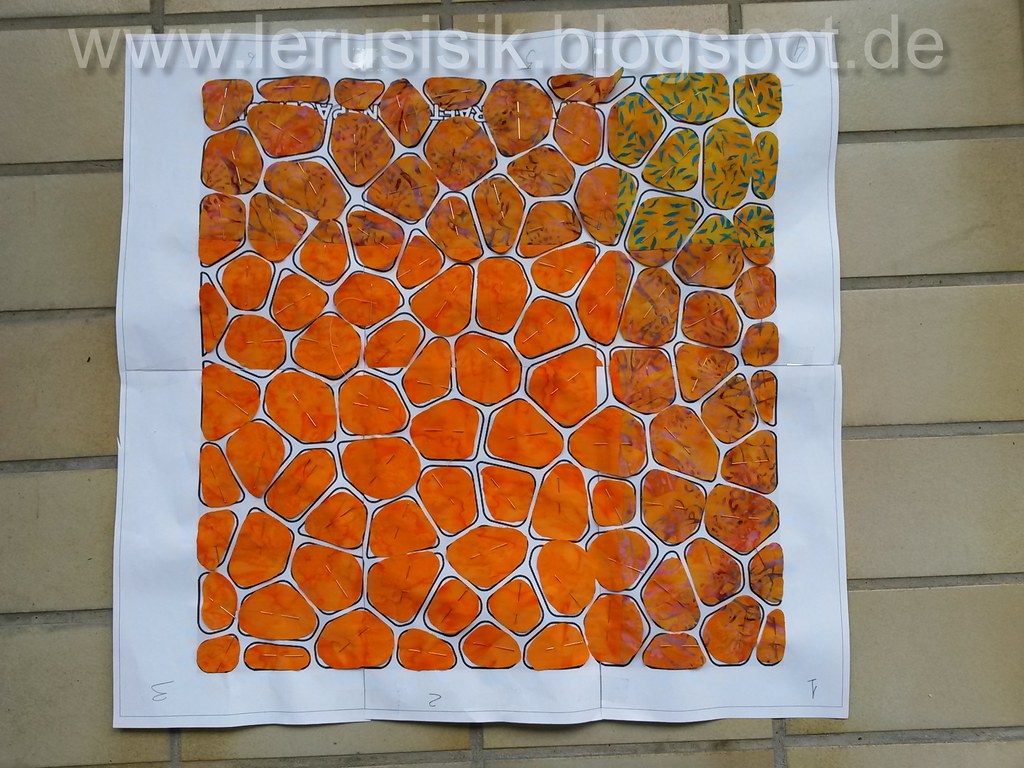D Die letzte Taschenchallenge in meiner Taschengruppe hieß "Tasche als/wie Kunstwerk". Die Aufgabe war Tasche zu kreieren die von einem Gemälde, einem Künstler oder einer Stilrichtung inspiriert wurde. Da ich überhaupt nicht malen kann, konnte ich nicht viele Kunststile in die engere Auswahl ziehen: weder Impresionismus noch Expressionismus noch andere schöne Dinge. Mir blieb nur die Schönheit der Geometrie übrig. Und was gibt's geometrischer als der Konstruktivismus, das Stil von Rotchenko, Tatlin und El Lissitzky, das Stil, der noch abstrakter und geometrischer als Bauhaus ist. Ich habe Recherche gemacht und kam zum folgenden Schluss: einfache Grundformen, einfache Farben und deren gegenstandlose rein harmonische Zusammensetzung - das alles kann ich selber machen ohne künstlerische Vorlage.
E And there was a new bag challenge in my bag group and the theme was "A Bag as a Work of Art". We'd have to make a bag or purse, of any size, matherial and purpose, that reproduces or resembles a real painting. As for me, I'm most definitely not a painting person. So neither classicism nor impressionism nor anything of that kind - except geometry. And the best examples of the geometric art are in the avant-garde - Bauhaus, constructivism, suprematism as the essence of it. Rodchenko, Lissitzky and Tatlin, you know. I've made researches and decided that simple basic forms, simple basic colors and a simple layout are things that I can arrange all by myself.
D Hier ist das Ergebnis meiner Studie. Die Tasche ist eher das Täschen: die ist 11 x 17 x 3 cm groß. Die Stoffe sind IKEA-Unis.
Die Tasche von der anderen Seite:
E Here is the result of me being a suprematist. It's a rather small purse (11 x 17 x 3 cm), all the fabrics are IKEA solids.
The other side:
D Es war nicht einfach, einen Kontrastfarbenen Reißverschluss rundum einzunähen. Ich habe schon in diesem Bereich einige Erfahrungen gesammelt und die waren nicht gut. Diesmal habe ich Kontrollpunkte sowohl auf beiden Taschenteilen als auch auf dem Seitenteil mit dem RSV sorgfältig markiert und immer vom Punkt zum Punkt zusammengenäht. Diese Technik erwies sich als anstrengend aber wirksam:
E One of the most challenging part of the purse was an outer zipper. I've got some bad experience already, so this time I tried to learn from my mistakes. I've carefully marked all pivot points both on the purse panels and the zipper part (8 points on every panel) and sewn strictly from point to point. It worked really good:
D Der wahre Konstruktivismus ist in der Tasche versteckt, weil das nicht nur noch eine Tasche ist, sondern ein Strick-Organizer! Die geometrische Formen aus der äußeren Seite verwandeln sich in die Innenfächer:
E The real constructivism begins inside, for the purse isn't just a purse - it's my new knitting organiser. The geometric shapes from the surface were slightly transformed to form inside pockets:
D Der wahre Konstruktivismus ist in der Tasche versteckt, weil das nicht nur noch eine Tasche ist, sondern ein Strick-Organizer! Die geometrische Formen aus der äußeren Seite verwandeln sich in die Innenfächer:
E The real constructivism begins inside, for the purse isn't just a purse - it's my new knitting organiser. The geometric shapes from the surface were slightly transformed to form inside pockets:
D Hier ist mein Strick-
E Here are all my very nesessary knitting notions:
D Die passen so hübsch rein:
E And they all pass so neatly in the pockets:
D Der weiße Hintergrund ist zwar nicht besonders praktisch, jedoch obligatorisch für eine Amateurkonstruktivistin.
Ich habe die Tasche schon getestet und finde sie einfach perfekt.
E The white background is not very practical, but as a makeshift constructivist I had no choice.
I've tested the purse already and found it just perfect for me.
















































